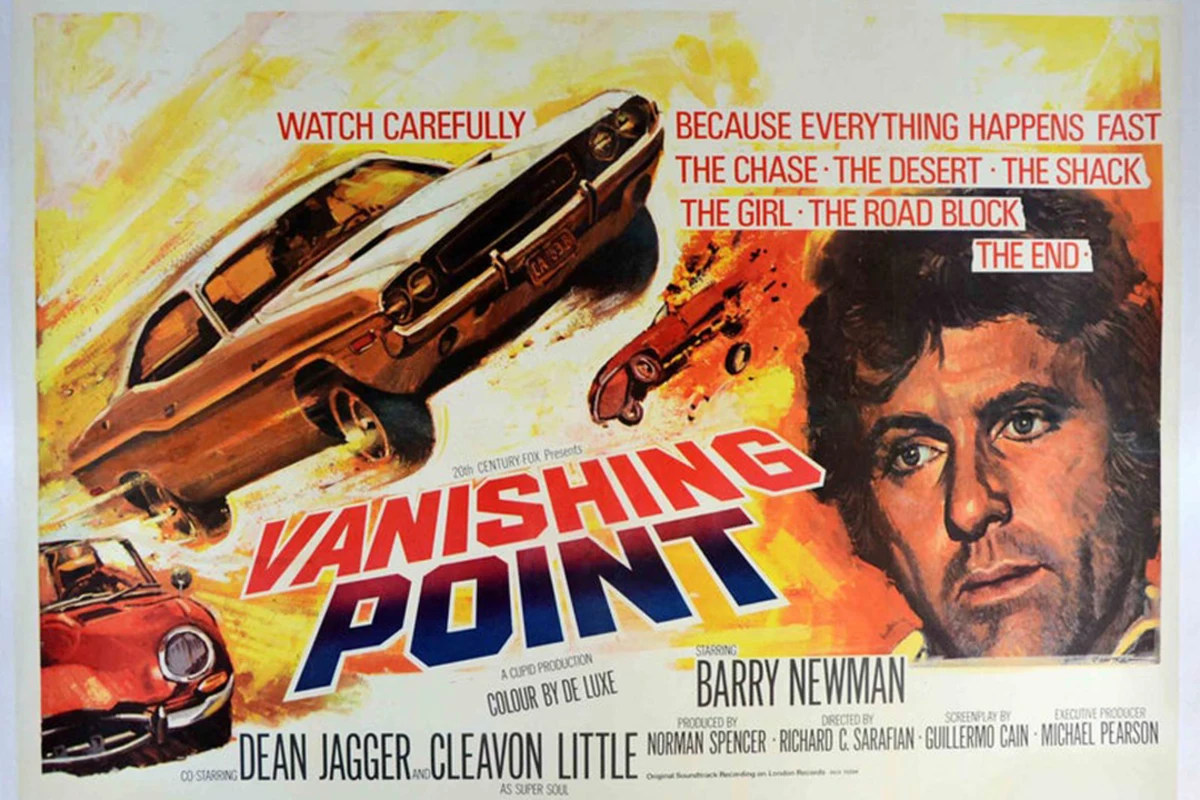In the late ’60s and early ’70s, the open roads of America — particularly the American West — became a kind of shorthand for two things: white-knuckled driving movies and the concept of freedom itself. Richard C. Sarafian’s Vanishing Point, which premiered on March 13, 1971, exemplifies this as well as any film of the era.
Once regarded as a pretty dull affair — the New York Times‘ reviewer called it “a movie about which I can think of almost nothing good to say” — Vanishing Point has now ascended to that hallowed realm of “cult movie,” coming in at No. 62 on a recent poll of the greatest action flicks. Its celebrity turn was also certainly helped by the oversized role it played in Quentin Tarantino‘s 2007 film, Death Proof.
Vanishing Point comes up in that movie repeatedly. It’s referenced early on by stuntman bad guy Mike McKay (Kurt Russell) as an example of an era when stunts were done by real men in real danger, not constructed with CGI. It’s also cited several times by his female nemeses, in particular when they discuss the car they want to drive: a white 1970 Dodge Challenger.
But even if Vanishing Point is mostly celebrated via action nods and gear-head adoration, it’s still a strangely affecting film — and much weirder than is often remembered.
As befits a movie about driving down the highway at high speeds, the plot is straight-ahead and unadorned. Barry Newman plays Kowalski, who has job delivering cars. He arrives in Denver late one Friday night to drop off an Imperial, and he immediately picks up another car — the famed Challenger — for a run to San Francisco. To help him with the job, he goes to a bar to buy some speed, and he bets his dealer he can drop off the car by 3PM on Sunday, even though there’s no reason for the rush.
But for Kowalski, the purposelessness seems to be the point. He wants to drive fast simply because he can, and no one’s going to stop him. He finds himself being followed almost immediately by a pair of Colorado highway patrol cops on motorcycles, but he knocks one off the road and outraces the other. He gets challenged to a race by a guy in a convertible Jaguar, running him off the road as well.
This pattern of high speed and random encounters continues all across the West. Kowalski races through Utah and Nevada, evading highway patrolmen and meeting odd strangers: a crusty old rattlesnake hunter (Dean Jagger) who helps him out, a bunch of Christian revivalists (featuring members of the band Delaney, Bonnie and Friends, who have a song on the soundtrack), two gay hitchhikers who try to rob him at gunpoint before he throws them out of his car and a biker with a girlfriend who rides around naked in the desert.
Meanwhile, news of these exploits has spread: He’s being cheered on by a blind, small-town Nevada DJ named Super Soul (Cleavon Little), who calls him “the last American hero to whom speed means freedom of the soul.” This attracts public attention to Kowalski, who’s becoming a kind of folk hero. But eventually the chase has to end. Just inside California, the cops set up a pair of bulldozers in the road and chase Kowalski toward them. Instead of stopping, he accelerates into the bulldozers, smiling, and dies in a fiery explosion.
A good deal of the film’s run time features the kind of stuff celebrated in Death Proof. Kowalski’s Challenger roars loudly, spews dirt and gravel when it rounds corners and engages in some great driving sequences set up by Carey Loftin, who also coordinated stunts on films like Bullitt and The French Connection. And all of this is set against lots of gorgeous desert scenery, courtesy of cinematographer John A. Alonzo.
But the film’s mysterious allure isn’t only derived from the high-speed sequences. It also comes from the strange characters Kowalski encounters along the way — and from the brief glimpses of his character that we’re given through flashbacks. We find out that he’s a decorated Vietnam War veteran, ex-cop and former race car driver, with a past girlfriend who died in a surfing accident.
These are all clues to the kind of “freedom” the film celebrates. Kowalski is an outsider, one who hasn’t been able to make it in the establishment world. His desire for the open road is a rejection of that establishment. And in a sense, this desire wins in the end: He never gets caught by the cops, dying rather than giving in. In a typical late ’60s and early ’70s way that recalls everything from Easy Rider to Two Lane Blacktop to One Flew Over the Cuckoo’s Nest, the stakes are clear: You’re either free or you die, and the former is better than the latter.
At the same time, though, this freedom is something to be mourned. Even while Kowalski is burning up the highway, Super Soul is announcing that the driver is “the last beautiful free soul on this planet.” This freedom will inevitably come to an end. And it’s been enjoyed at a terrible cost. Once a war hero and a man who knew love, Kowalski is now nothing more than a drifter, with no ties to anything or anyone he meets.
Although it’s often read as a kind of existentialist parable, the film is more like a celebration of kinetic energy itself. There are no morals here, no real message. There’s only forward motion: the sound of that glorious 440 engine and the sight of the highway rushing past.

